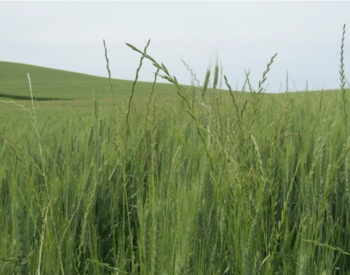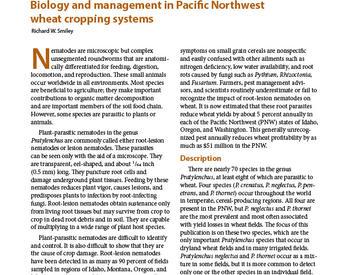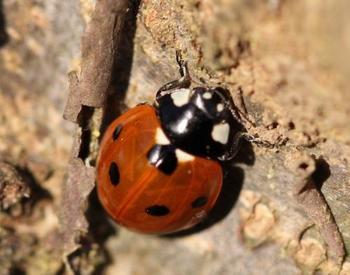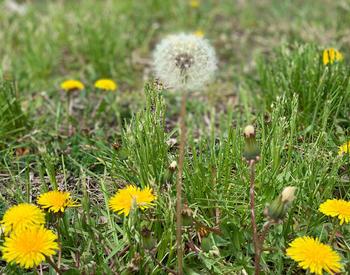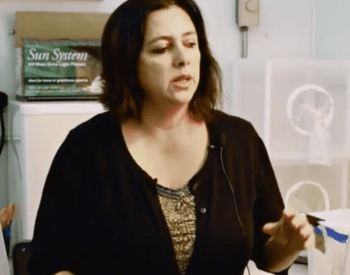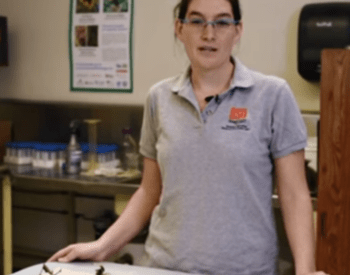Transcript
[00:00:00] Andony Melathopoulos: Oregon over the past month has become the populated of commercial honeybee colonies, but don't worry. They're okay. They've just headed south to pollinate California almonds. And as we've heard in previous episode, there's been huge investment in creating pollinator habitat in and around California, almond orchards, this kind of investment hasn't been matched here in Oregon.
[00:00:19] And this is in part because we have such diverse agriculture. So there's. Pollen and nectar resources around nonetheless, when those bees come back in March and get ready to pollinate blueberries, it'd be really helpful if there was a little bit more pollinator habitat in and around those fields. My next guest is a real pro in doing this George Kaufman works for Agra care and I met him out at humbug farm.
[00:00:45] And independence, Oregon, where they've made some really amazing investments in a large scale commercial blueberry field in terms of pollinator habitat, lots of different shrub species also for flowering Forbes. And in this episode, we're going to hear about how the. You know how they're able to establish these plots, maintain them and keep them going for years.
[00:01:07] The plot that we visited in this episode has been growing for a number of years and looks fantastic. And before we get started on this episode, I just want to mention that this episode is part of a larger Western IPM center grant, looking at integrated pest management and pollinator protection and agriculture lands.
[00:01:26] So this is connected to that episode. Earlier with Nico from Peoria gardens talking about integrated pest management and pollinator health in nurseries. The goal of these episodes is to really give growers some ideas and tools on how to help pollinators at the same time as protecting their crops and some innovative solutions from the ground up.
[00:01:45] So without further ado, let's go to independence, Oregon to learn about pollinator habitat this week on pollination.
[00:01:54] George Kaufman: Walk on this side, a little less muddy. Okay, great. So
[00:01:58] Andony Melathopoulos: here we are. We're so welcome, George. Welcome to pollination.
[00:02:01] George Kaufman: Thank you. Thanks. So where are we right now? Oh, we're in independence, Oregon at humbug farm.
[00:02:06] It's this and the sister farm across the road. It's about a thousand acres of organic blueberries and. 1200 acres of hazelnuts that are conventionally grown. And it's a farm that we planted about eight years ago. Okay.
[00:02:18] Andony Melathopoulos: This is what, an eight year old blueberry planting looks like.
[00:02:21] Okay, great. But there's something peculiar right in front of us. This does not look like a road blueberry.
[00:02:27] George Kaufman: No. We actually down the middle of both farms, we, instead of planting a row blueberries, we just took that row and instead put various species of native flowering plants. With the intention of helping support the native insects and bees and native pollinators, native beneficial, predatory insects.
[00:02:45] And so just, yeah, set a little ground aside for that purpose. Yeah,
[00:02:49] Andony Melathopoulos: I imagine for some people I'm looking at this and it's man, we lost the low road blueberries to this, or. I imagine with other people putting a hydro in it's like in the way, the equipment, why did you guys decide to, and this is a beautiful, I have to say, just looking at this is this is the textbook definition of like, how to do I had drove, this is outstanding.
[00:03:07] So why'd you guys go to so much trouble to do this?
[00:03:10] George Kaufman: Yeah. So this hydro is a little unusual. It really does go right down the middle of a productive ground. It splits the farm in half. A lot of our plantings you'll see are on the outside the outskirts of the farm where there's maybe a unusual sized, corner or something, or the hill Hills too steep to farm.
[00:03:27] But really when this farm was planted the owner of the farm. Conservation like this sustainability, it really is a big part of their core values. Something they actually believed in and something that they actually put their mouth or their money where their mouth was. And they it really, we didn't know, I guess what the benefits were going to be actually to the farm, but we knew that by putting this hydro in that we could support the native insects previously this farm was based basically.
[00:03:53] Large blocks of, monoculture and it still is. But this is, plants like corn grass, seed, peppermint, things that are rotated and not always real supportive for the local insect populations. And so we knew by taking by putting a permanent hetero here that we could really, help support.
[00:04:11] Boosts back those beneficial number, insect numbers that probably declined over the many decades of farming here. And I have
[00:04:18] Andony Melathopoulos: to say the reason why this looks like a textbook, examples, the establishment is so carefully done. Sometimes I think, people will put shrubs in the ground and hope it comes, but here we've got a good weed.
[00:04:30] We've got good weed control. There's some irrigation going on. These plants
[00:04:34] George Kaufman: there is, I don't, we don't use it too much anymore. That was for establishment. I
[00:04:38] Andony Melathopoulos: imagine that's the thing at the establishment phase for a lot of plants. You don't need it after that, as soon as they establish their good with these kinds of shrubs, we've got spirea
[00:04:47] George Kaufman: here.
[00:04:48] Yes. Yep. And I think all these shrubs in here are native to the valley here, so they're used to hot dry summers. And once they get established, yet we don't water. We just, we try to keep our inputs at a minimum. This. Because this is a road blueberries and an organic farm, it or was going to be a row of blueberries.
[00:05:02] Originally there's a irrigation installed there's weed fabric installed. And then instead of putting blueberry holes, we just, we put these pollinator plants and the weed fabric has made it really easy to control the weeds. And I think that's just the long-term upkeep of these hedgerows, I think is maybe a big reason why people are a little bit scared or nervous about doing these projects.
[00:05:22] So you really got to do them, do it right upfront. By doing this, we fabric, we have very minimal weeding that has to be done every year. You can see it right here. We've got some, yeah, exactly. We've got roses in front of us. They filled in their little hole nicely. It wouldn't be forever. Oh
[00:05:38] Andony Melathopoulos: yeah.
[00:05:40] That's
[00:05:40] George Kaufman: great. That's neat. Yeah. So there's no weeds that are me coming through here. I imagine this
[00:05:44] Andony Melathopoulos: is the problem. I've seen this in the valley repeatedly. Someone puts in a pollinator, Headrow or something was shrubs and then the black. Just, and I don't see us. How old is this?
[00:05:56] George Kaufman: Almost eight years old.
[00:05:57] Andony Melathopoulos: Yeah. I don't see any patches of Blackberry in here. This is really.
[00:06:01] George Kaufman: Yeah. And this was planted in the middle of a farm that had been, managed very well for many years. So there isn't gonna be a lot of blackberries. If you go on other parts of farmer where we planted the outskirts, that's where he had blackberries.
[00:06:12] And so those a few, popping every year, we cut them back. We do use some herbicides, on the spot spray to get rid of those. Because if you don't. Come back five years from now. It's all you have is blackberries. So you're going
[00:06:23] Andony Melathopoulos: to have Blackberry. So yeah. So tell us a little bit about for something like Blackberry management I guess you just, it's a yearly thing you're going to have to come through and just co even when it's well-established, the blackberries could just go right through everything.
[00:06:37] I imagine coming by here once a year, what time of year are you like
[00:06:40] George Kaufman: thinking about Blackberry? Fall late fall into early winter is a great time. Cause most of the plants have lost their leaves, but the blackberries still have their leaves on. So they stick out like a sore thumb. They're very obvious.
[00:06:51] They're the only about green plant that's out there. So they're really easy to see really easy to come and clip back. And then like I said, we do use some herbicides spring, when they start to grow back, that's a good time to just go in, hit just the blackberries with a little spot spray and to kill that plant otherwise you could try to pull or dig out the plant, but for us, we managed quite a few acres of habitat and so we have to make it make as easy and quick as possible
[00:07:13] Andony Melathopoulos: being in the blueberry business and just being really good at.
[00:07:16] So you clearly know how to get a weed fabric down in an efficient way. Can you tell us a little bit about this? And I imagine for many people, unless they're growers, this is impossible to do like this.
[00:07:26] George Kaufman: Yeah. So we have a special machine that comes in and lays down fabric on both sides of the.
[00:07:32] And then it's closed up with fabric staples, and then we put a hole on top for the plant. I suppose if you didn't have that machine, you could, you could go out and purchase a strip of weed fabric. And then do you just want to make sure you secure it? So you just gotta, you probably wanna put dirt on the edge just so you don't have wind coming in and lifting it up and take taking it away, make sure you use, fabric, staples, things like that to, to keep it secured.
[00:07:53] That's the big thing. You're going to have, voles here and there that like to run underneath it, but for the most part, how long will this last? This is eight years old here. It's still in really good shape. Great. You can see the blueberry fabric behind this.
[00:08:04] It's a little bit more beat up cause we've ran machine harvesters over it. We've opened and closed it, but th this has, easily another 10, 15 years on it. I think this is going to last us. Now,
[00:08:14] Andony Melathopoulos: I guess one of the things in consideration when you're in blueberries or small fruits is spotted winger softly.
[00:08:21] And I guess some of these, some plants that are good for bees blackberries, a great example can be a host. Tell us a little bit about plant selection and making it. Compatible
[00:08:31] George Kaufman: with the growing system. So if you walk along this, Headrow, you'll notice none of these plants fruit. So unfortunately that eliminates quite a few plants, but we have, roses, we have a spy Rhea Pacific ninebark oh yeah.
[00:08:43] Mock orange there's a. Pretty wide variety of plants that you can use still that don't, I don't fruit. And obviously, yeah, we didn't want our our native pollinator habitats to end up being a host site for pests. And so we carefully selected plants. Oregon state has a great public publications on, which plants.
[00:09:01] There's other diseases or insects people are worried about. They get that's extensions, a great resource for that.
[00:09:08] Andony Melathopoulos: Now I guess the other part of this, there's all sorts of native pollinators that are going to come here, but imagine Agra care and the owner. Farm rent, a lot of honeybee colonies.
[00:09:18] What had been the beekeepers receptions the reception to having these Tedros in these in these flowering Hydro's in place.
[00:09:24] George Kaufman: Yeah, it's been good. So it's no secret that. Blueberries are hard on honeybees, right? They're just there they're pollen and nectar just aren't real nutritious.
[00:09:33] It's a lot of work for the bees to get the pollen and nectar out. And so a lot of these heteros begin to bloom about the second half of a blueberry bloom. So about the second half of the honey bees being in here and And so that, that gives them the honeybees and alternate source, right? It's not enough ground that it's going to distract from the blueberry pollination.
[00:09:50] But it's enough to help boost up the health and then the nutrition of the hives. And so we're actually going to be working this year to quantify that better and get a better idea of, how much good these habitats are doing for us. But we expect that we'll see stronger colonies leaving the farm when they're, on a farm that has, good pollinator habitat, good blooming plants as opposed to farm that does not have any alternate sources of food.
[00:10:12] Other than blueberry. I can
[00:10:14] Andony Melathopoulos: just imagine that is a concern. If I was a blueberry grower, I put too much, I'd be worried about putting in flowering plants around bloom. There are some varieties of blueberry understand the bees. Really? If you have some blooming maple close by, they may leave. And so w how, yeah.
[00:10:33] Tell us a little bit about that process. I imagine you're not, you've got a balance between area, and then you've got the, you don't have the bloom right up against. Bloom's starts for your
[00:10:42] George Kaufman: blueberries. Yeah. Yeah. So things like blooming maple, a neighboring mustard field, those are really hard to compete with.
[00:10:48] And those are there's enough plants, a large mustard field can just. Lots of honeybees away where it does have a detrimental effect on the pollination of blueberries with our head DROS. Our opponent habitat pollinator habitat makes up about 5% or so of the farm acreage. And so on a thousand acre blueberry farm, that's about 40 acres of habitat.
[00:11:07] That's not blooming all at once, right? We, these hedgerows are pretty dense. There's quite a few flowers in them. Yes, there's bees on it that second half, but the plants are just beginning to bloom. There's not lots and lots of blooms on the head rows. And obviously so you have a portion of bees that go on these heteros, but it's not enough where you feel like it's being, detracting from the blueberry, the bloom.
[00:11:28] And there's only so much pollen and nectar out here that, once they take it that morning, that day, that they're going to go somewhere else so they can find. Yeah, the food sources.
[00:11:36] Andony Melathopoulos: And there's the honeybees and I, I, it's always great to, that there's a blueberry.
[00:11:43] And I'm doing something to help their beekeepers because it is a difficult pollination. But I imagine the flip side is there may be some benefit that clearly getting bumblebee densities high in a commercial blueberry field is difficult. They're a great pollinator, but just getting the numbers high enough.
[00:11:57] But I understand you guys are actually tracking native V populations. Tell us a little bit about that
[00:12:02] George Kaufman: effort. Yeah, so we've pretty closely tracked at the last five or six years. Native bees, native, beneficial insects over the period of basically from late March, early April into September. And just watching what those numbers and those populations have done.
[00:12:17] We've seen as these farms have got established and matured, we've seen about 28, 30% increase in the counts on beneficial insects every year. So we're growing these populations, very quickly. And then we were starting to observe bumblebee sticking around the entire summer, right before they would sit around during, blueberry bloom and they'd stick around maybe while we had some of our head rose blooming, but then they eventually, they just disappear and we're doing a better job of incorporating late season blooming plants.
[00:12:46] And what we've seen is there's enough, florals resources for these bees that they're sticking around. And so they're hopefully having lots of babies. And then, we're having lots of Queens overwintering on our farm. And so when they come out, they're right here on her farm.
[00:12:57] And so that's kinda why we want to keep them around all summer long. So they overwinter here. And so we're seeing, We've compared this farm to other farms of ours that don't have this mature of habitat, don't have this much habitat and we're seeing maybe five, five, five to 10% more of our pollination is done by native bees.
[00:13:18] That's amazing. Then a farm that has no habitat next to
[00:13:21] Andony Melathopoulos: it. So you're getting this kind of free. Not free. You're having it. This is, you got to put the habitat in place, but it is after you make this investment. A trickle of free pollination service, maybe superior pollination service.
[00:13:33] George Kaufman: Absolutely. Yes. Yep. That's great. And we've looked at like aphid numbers on the closer you get to the head rows. The fear aphids are right, because you're having more of those parasitoid wasps and more of those predator insects as adults, maybe that feed on the pollen and nectar, and then come out here and lay their eggs, on the aphids or in the aphids or their babies, or, feeding on the aphids.
[00:13:52] And so we're actually seeing fewer aphids closer to these habitats. And so that's if it's can be. And the right circumstance. It can be a pretty bad pests on fishy organic blueberries. We don't allow tools to define them. And so that's a really important benefit we're getting is, I was just
[00:14:08] Andony Melathopoulos: part of a ag leadership course.
[00:14:10] I just, I was on my way back from Salem and we had an opportunity to meet here. And I guess one of the things is a lot of people in cities don't really recognize how much growers are doing to help pollinators. Is there any other ways that you get recognized for doing this work?
[00:14:26] It's it's a great story. It is shocking that it's taken me so long before I've done an episode with you. Cause this is just folks I'm just telling you as far as the eye can see there's a pollinator Headrow. And is that important to you guys? Or it sounds like just controlling aphids, keeping beekeepers happy.
[00:14:43] All this doesn't involve the public at all. Is there a way in which the consumers get to know about about these efforts? A couple
[00:14:50] George Kaufman: of ways this farm was a part of the, was a flagship farm for the Oregon bee project. And then it's also a certified B better, which is a certification created by the NRC society.
[00:14:59] And so basically we're certified that. Practices that we have habitat in the farm that supports beneficial insects. And so part of that is, just the number of acres or the percentage of our farm that's allocated toward beneficial habitats. Part of it's just the different pest control products we use on our farm.
[00:15:18] It's, we can only use certain things certain times a year and then just buffers between. Our blueberry plants and the native habitat, making sure that we don't have any spray drift or anything like that. And about two or three years ago, the first B better certified blueberries came off this farm.
[00:15:32] It's something that you can find, in the store and in the summertime. Homegrown organics is one of the main labels out there and there'll be like a little, be better certified sticker on. And that's a great way to support farms like us that are doing the work is by, buying our product that certified be better.
[00:15:47] Andony Melathopoulos: Now you can see the amount of investment and effort that goes to get that certification.
[00:15:52] George Kaufman: Absolutely. Yeah. So it's something that. It aligned with our core values anyway, what the farm was doing already. And so it, it wasn't too much of a stretch to get that certification. A farm that's not doing anything it's attainable, but there's going to make some changes, put in some habitat and maintain that habitat.
[00:16:08] Andony Melathopoulos: Right now I can see the blueberries. W we're recording this. Just in, in the middle of February how far along are they? How are they, how are blueberries looking right now?
[00:16:17] George Kaufman: They are looking good. You can see that the buds are Swan a little bit, but we're still, this variety is still probably, oh, I'm a month and a half away from breaking bad and I'm starting to bloom, but yeah, the majority of our bloom is in the month of April and today.
[00:16:30] And that's when
[00:16:31] Andony Melathopoulos: I imagine you're always busy, but things really get moving for you at that point. Do you ever get a chance to stop and smell the roses, so to speak? Do you see any, is there any beads that you see that you're really excited to see? Yeah,
[00:16:42] George Kaufman: if you follow me around here on the farm, you'll see that I, I.
[00:16:45] I always stopped at the head rows. I just, it's fascinating all summer spring into summer, just different blooming plants. And I love bumblebees. I really love when there's a cloud of like parasitoid wasps or clouded, really tiny insects that just are surrounding like like a seed notice or some kind of Bush that he like that.
[00:17:02] For me, that's neat because. You don't really, if you don't take time to see that you won't see those, but you realize that's where the benefits coming in is just the massive number of insects, beneficial insects that we're supporting with these head droves. And then, and knowing that, they're gonna fly out into our crop and they're going to feed on the aphids, or they're going to, lay eggs in the aphids and help us control that.
[00:17:19] And yeah, I spend a decent amount of time smelling the roses. It's a favorite part. I have,
[00:17:24] Andony Melathopoulos: maybe this is the last question. Maybe this isn't an involved question. When you walk down and you look at some of the things that you've planted in the past in terms of ease and in terms of like benefits, what are some of your top plants in this in the heteros that you guys have put in?
[00:17:37] George Kaufman: Top plants would probably be Douglas. Douglas, Astor's just a work horse from July until it freezes. Basically, we're trying to incorporate more golden rod just because we see so much, so many beneficial predatory insects on there. Oh,
[00:17:52] Andony Melathopoulos: I didn't realize that. So I'm seeing the shrubs right now, but there's Forbes, perennial
[00:17:56] George Kaufman: forums.
[00:17:57] There's a spot right there. It's just shorter than. He either needs to get replanted or there's some asters that died back over the winter and you can see some shorter ones up there where that's been the most difficult thing. And I think I mentioned it earlier, but it's just having enough blooming plants from that July through October window.
[00:18:16] And so really the main plants that you're gonna to get at that point are going to be a lot of perennials, herbacious, perennials. So asters, we're going to try to include some more. Like coneflower golden rod is one that we're trying to get. It's going to be. Yeah, cause I w we've had it on a couple of our farms and they're just covered with soldier beetles and all these neat little insects and such.
[00:18:38] But yeah, and then the roses are good. We did. So I mentioned Douglas Maria. We did, I, it was my mistake. We did Alpine spray area. That's supposed to be at a higher elevation and it's free. It's about dead. So we'll be pulling those plants and replacing them with some of the later season blooming.
[00:18:56] But that's really important that you try to find a wide range of blooming times. Basically from that early spring and to up until frost or through the front, the frost. And that's one thing we've in the past couple of years I've been working more on is incorporating those type of plants into our head rows, into our border habitats.
[00:19:12] So we have those resources all summer long. And that you can keep insects, you can continue to grow those populations. And then hopefully the intention is to have a high overwintering prop population that's there next spring. Start out with a bang and, cause blueberry bloom is April's pretty cold month really.
[00:19:27] And there's not a lot going on. And so bumblebees are the main ones out there. And that it's, there's the queen bumblebees. You see them out there at first. There's not a lot of insects. And so you need to have high overwintering populations if you're going to get good. Good. Polished and services, from native insects.
[00:19:45] W
[00:19:46] Andony Melathopoulos: I said it was the last question, but I also just, I'm looking at these roses and I imagine some of these things die back and they don't get in the way, but this rose looks like it. If it was left, unpruned, you'd be, it'd be all over the place. Is there. Every year you'd eat at some point. Do you come through and prune some things back and
[00:20:06] George Kaufman: yeah.
[00:20:06] So you can see about, oh, a couple of feet off the ground where it was cut back last year. So this is how high it was two feet last year. It's now good. Wow. Eight, nine feet tall. They grow right back. We made the mistake last year of cutting back everything. And at that X, that delays bloom by a couple of weeks.
[00:20:24] And so we didn't quite have bloom as early as we wanted to. What our plan is moving forward is we're going to move, prune back sections of it. So we might come in here and cut maybe half this back. So that way. The section that's left, blooms normally, and then this'll bloom, two weeks later, that's actually a good thing because it helps extend your bloom time.
[00:20:41] Because
[00:20:42] we're
[00:20:42] Andony Melathopoulos: looking at maybe like a 20 foot, little section of roses here. So if you do a bit, there's going to be like 10 feet or five feet that's going to be.
[00:20:50] George Kaufman: Yeah. Yeah. And then the, actually that Douglas spidery, that's another one we'd like to prune back. Cause that will, that delays balloon by two, three weeks.
[00:20:55] And there's that kind of window. And. May and June where it just everything's blooming. And then you start that June to July before the Astro comes on there. It's a quiet period. And so if we can delay that Douglas ass, the Douglas by area by a couple of weeks, that kind of helps fill that gap in and in late June in the first half of July.
[00:21:13] So there's kind of some tricks there. Nothing that we've grown is weedy. You can see the roses are starting to creep out here, it's grass right here. We mow it. They're never going to become a problem. They're going to stay back there. Pop up in the grass. Look, they'll get mowed back.
[00:21:26] Andony Melathopoulos: Oh, when you go to a Hydro's is on the edge, I imagine it's one thing to manage weeds and other pressure. When you do have a GRA isn't the same thing over there. You've got a nice grass alley where you can make sure things stay
[00:21:37] George Kaufman: in place. No. So when we do like large plantings, like on the unproductive side corners of the farm, we do use herbicides and that's that's the easiest way.
[00:21:47] It's a, pre-emergent keeps the weeds down and. As these plants grow and fill in, you get fewer and fewer weeds. It's really not much of a problem. Blackberries are going to be a problem. And there's some other very vigorous weeds. Thistles are another one that you got to manage, but for the most part, once these start to fill in and grow together, there's weeds.
[00:22:04] Aren't too big of a problem. Seven, eight feet tall. These plants are so nothing really snuffs them out too much.
[00:22:10] Andony Melathopoulos: Fantastic. Thanks so much for taking the time. This is a really impressive effort that you guys are doing here. It's really looking forward to other growers in the valley and beyond starting to incorporate some of what you've learned
[00:22:22] George Kaufman: here.
[00:22:22] Thank you. Thank you.
Creating habitat for beneficial insects is a key part of Integrated Pest Management (IPM). In this episode we hear how an Oregon blueberry farm has gone large scale in creating pollinator hedgerows.
George Kaufman is a crop advisor for AgriCare, Inc. Halls Ferry Farm is a large-scale farming operation that focuses on producing organic blueberries and hazelnuts. Boasting 2,500 acres of farmable land and hedgerows as far as the eye can see, Halls Ferry Farm wants to change the narrative about what big farms do. “People think that small- and medium-sized farms are the only place where you can execute on big sustainability ideas. Our purpose is to increase access to better and healthier food,” says Wood Turner, who represents Ag Capital, the owners of Halls Ferry Farm.
Links Mentioned:







